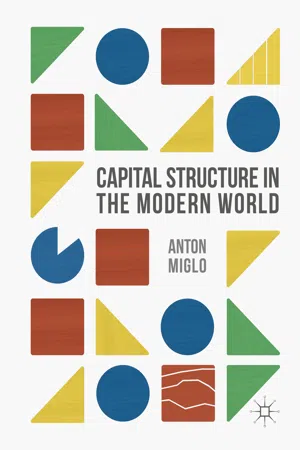1.1 The Capital Structure Problem
Capital structure is a firm’s mix of debt and equity. For a long period of time, capital structure was considered a very “technical” area that concerned at most one or two employees in an average company. To a traditional business person, this area was unlikely to generate significant revenue compared to other areas of finance such as rightly chosen investment projects. In recent years, the situation has changed significantly. Capital structure has become an incredibly important and intriguing area of theoretical and practical finance. Here are some examples.
In 2009, former Google CFO Patrick Pichette was asked by James Manyika from McKinsey consulting firm: “On that point, to what extent do considerations about capital structure factor into your thinking?” Mr. Pichette said that capital structure matters a lot. He also connected the problem of capital structure to the degree of business freedom: “If we could predict the strategic flexibility we’ll need in such an uncertain environment, we could optimize the balance sheet perfectly. But consider the constraints: leverage [capital structure! A. Miglo], dividends, and so on. Then call me the next day and say, ‘Hey, I need something. I’m inventing X.’ But I can’t help—I don’t have the flexibility—and end up giving up what could be the most important asset the company needs in order to change over the next 10 years. We believe there’s an opportunity cost of not having that flexibility….”1 As we will later learn, Mr. Pichette is talking about the relatively recent flexibility theory of capital structure. Usually it means keeping the amount of debt low.
Conversely, famous fast-food chain McDonald’s does not mind using more debt. In July 2007, according to an article entitled “McDonald’s reviews capital structure, CFO retiring”, McDonald’s announced the retirement of CFO Mr. Paull and at the same time announced that they were issuing more debt. They argued that it will help increase the return to shareholders.2 Just recently, in 2015, McDonald’s again used a similar strategy.3 Unlike Google, McDonald’s assets structure has a much higher fraction of tangible assets, which, as we will later learn, usually makes debt financing more affordable and meaningful. McDonald’s business relies significantly on franchising and a lot of their investments depend on their franchisees. They have a limited ability to raise equity capital and therefore debt financing is a logical choice. Using debt may also be related to the problem of providing additional financial discipline. As we will later learn, this idea is called “debt and discipline” theory.
In the last 10 years there has been a growing interest in the capital structure of start-up and small companies. Traditionally, it was assumed that most financing comes from entrepreneurs’ friends and relatives and the rest possibly from venture capitalists and angel investors. The role of banks and external debt financing was not important. Recently, it was discovered that firms that use external debt perform better than those who do not. Kauffman Foundation, dedicated to entrepreneurial research and support, in a publication entitled “The Capital Structure Decisions of New Firms,” suggests that contrary to widely held beliefs that start-up companies rely heavily on funding from family and friends, outside debt (financing through credit cards, credit lines, bank loans, etc.) is the most important type of financing for new firms, followed closely by the owner’s equity. These two sources accounted for about 75 % of start-up capital.4
What are other reasons for capital structure being a “hot” area in finance? First, a series of surveys conducted among financial executives revealed that a very significant gap exists between the theory and practice of capital structure. In one of the most notable works in corporate finance Graham and Harvey (
2001) wrote:
“In summary, executives use the mainline techniques that business schools have taught for years, NPV and CAPM,5 to value projects and to estimate the cost of equity. Interestingly, financial executives are much less likely to follow the academically prescribed factors and theories when determining capital structure. This last finding raises possibilities that require additional thought and research. Perhaps the relatively weak support for many capital structure theories indicates that it is time to critically reevaluate the assumptions and implications of these ...
